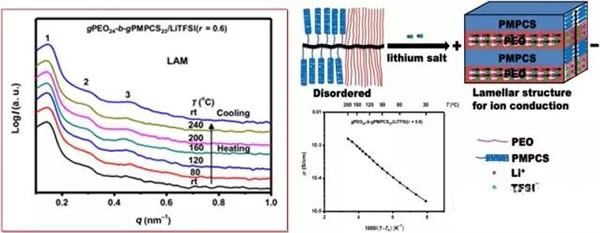Recently, Prof. Fan Xinghe and Associate Professor Shen Zhihao of the Department of Polymer Science and Engineering of the School of Chemical and Molecular Engineering of Peking University successfully developed a new type of lithium battery solid polyelectrolyte membrane with high temperature stability, which is expected to break the existing lithium. Ion battery solid electrolyte research, industrial structure. Related research results SolidPolymerElectrolyteswithExcellentHigh-TemperaturePropertiesbasedOnBrushBlockCopolymersHavingRigidSideChains has been published online in an international journal (ACS Applied Materials & Interfaces, 2017, DOI: 10.1021/acsami.6b15893). With the dual pressures of energy crisis and environmental protection, the market size of lithium-ion battery applications has been rapidly expanded, but there are also some potential security risks. There have been reports of dangerous accidents such as the explosion of mobile phones and automobiles. Because of its good thermal stability and mechanical strength, solid polyelectrolyte has become a research hotspot for scientists today. The PEO/lithium salt composite system is a type of solid polyelectrolyte. Because of its good thermal stability and mechanical strength, solid polyelectrolyte has become a research hotspot for scientists today. In lithium-ion batteries, the currently used PEO/lithium salt composite system, when the temperature rises above 120°C, the composite system softens, loses its mechanical strength and supporting function, and the lithium ion battery short-circuits. On the other hand, flexible block copolymers are not stable enough at high temperatures. These two factors make the use temperature of lithium-ion batteries below 150°C. Based on the above considerations, Prof. Fan Xinghe / Associate Professor Shen Zhihao and his team members successfully developed an amphiphilic block copolymer polymer brush with rigid polymer side chains. Due to the large repulsive force between the side chains of the polymer brush, the interaction parameters between the blocks are improved, and the self-assembly of the copolymer brush is facilitated, and the stability of the micro-phase separation structure is improved. This PEO-containing polymer brush also maintains its original self-assembly structure at high temperatures, which is beneficial to increase the stability of the polyelectrolyte. The lithium salt complex system of the amphiphilic block copolymer polymer brush containing a rigid polymer side chain has a high ion conductivity at a high temperature and is expected to solve the potential safety hazards of the lithium ion battery currently used in the market, and can greatly increase the problem. The safety of the battery is applied to lithium-ion batteries that are used at high temperatures such as rockets, satellites, or aircraft that need to withstand high temperatures. The results showed that the lithium ion conductivity of the ion battery prepared by using the amphiphilic block copolymer polymer brushes with rigid side chains increased with the increase of temperature and the ionic conductivity at 200°C. 1.58×10-3S/cm reached the highest level of ion conductivity of PEO-containing solid polyelectrolyte reported in the current literature, and it can be applied to solid polyelectrolytes in high-temperature lithium-ion batteries. The research results have great industrialization prospects and is expected to change the existing lithium-ion battery industry structure. The study was funded by projects supported by the National Natural Science Foundation of China. Gravure inks also called gravure liquid Ink, is a stable colloidal dispersion of colored, available printing methods appropriate to a coating on a suitable substrate, it presents the text patterns and colors and provide information and attract force. Like with other Printing Inks, gravure inks major component of colored substance (Pigment) and binders. Wherein the colored material from the color effects, by color and contrast different substrates, showing the images on the substrate. Only the proportion of each component of the deployment of good ink, in order to achieve proper ink printability and performance in order to make printing inks and printing plates, to be a good fit between the printer, printing material, the printing process smoothly. Ink Gravure Printing Inks, Printing Ink Industry, Low Temperature Plastisol Ink Dynasty Chemicals (NingBo) Co., Ltd. , https://www.dychemco.com
Solid Polyelectrolyte Structure and Ionic Conductivity
Gravure inks are mostly volatile solvent-based inks, the pigment, solid resins, volatile solvents, fillers, and additional agents.